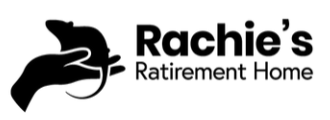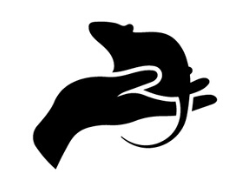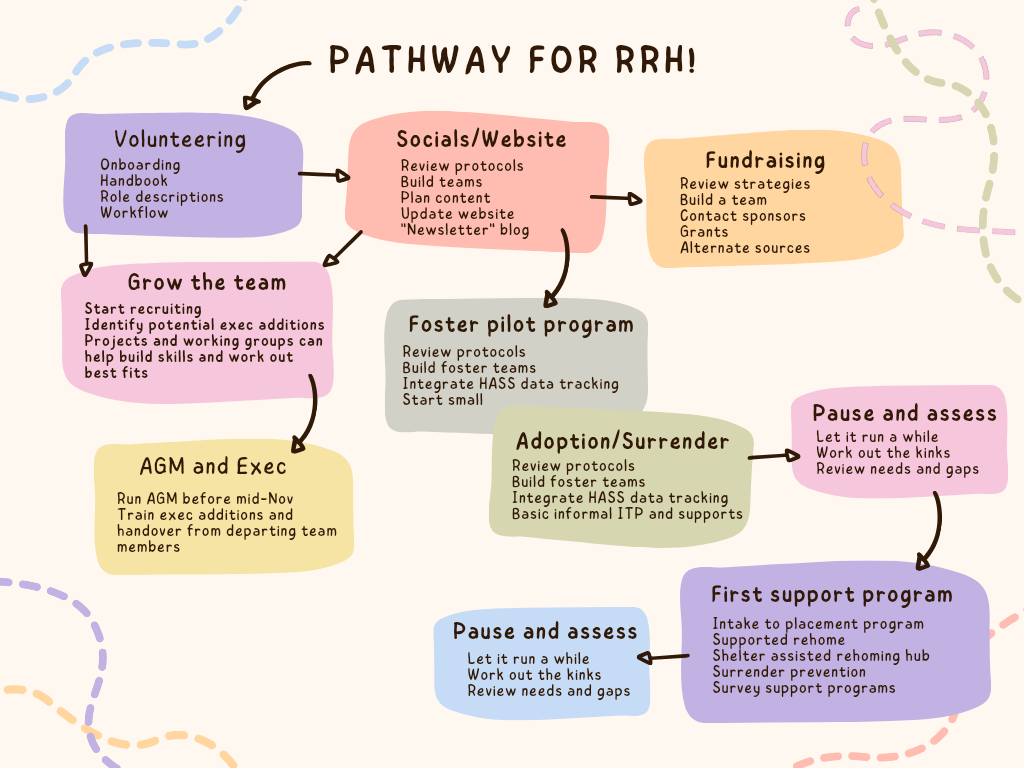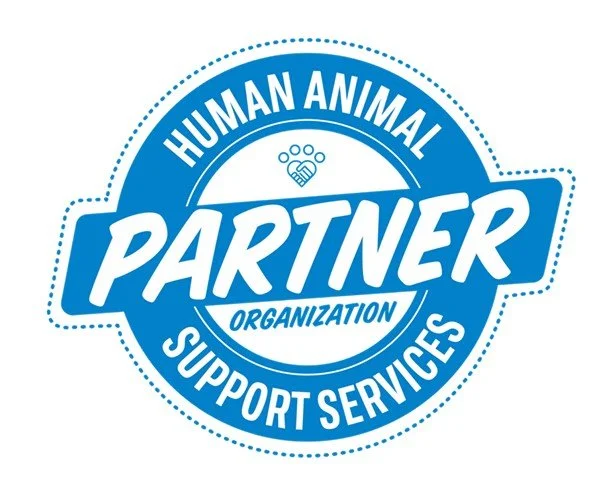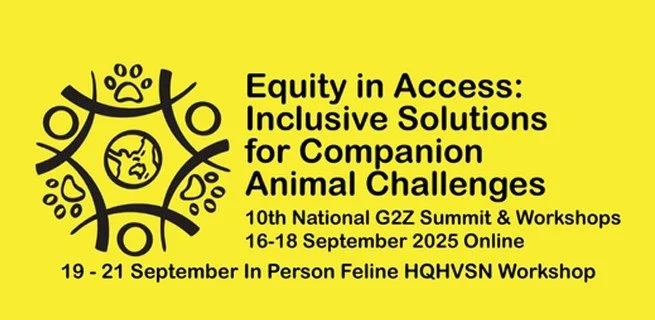Newsletter - Quarter 3, 2025 - Rebooting after the break!
May - September 2025
Hey everyone, Grove here!
It’s been a few months since we reconvened, and there has been a lot happening behind the scenes, quite a bit of really exciting news! I’m here to update everyone on how it’s going, and what our next steps look like.
The steps to reopening…
May marked the end of our year-long break. Well rested and excited to reconnect, we put a call out for interest in reconvening to discuss where to go from here.
In June, faces old and new came together to discuss a detailed proposal, and as a group we decided to go ahead with opening back up! With the rental crisis still a huge problem, the obvious solution was to simply change structure from a shelter to a rescue group - much the same as what we already did, having a group of volunteers supporting foster carers to rehabilitate rats, but just without having a central location, animals going directly to and from fosters. This is a pretty common structure in cat and dog rescues, and while shelters are also a necessary part of the system, this is now actually considered more optimised welfare - even for a shelter like ours where the rats could happily have all their needs met, it’s still far better to stay in homes and be the center of attention, with minimal disturbances.
We do hope to have a physical site again one day, to act as a community support and resource hub, and facilitate our work, but that’s a long term goal when funds allow, and we’re running a high enough volume of support to justify the need.
The steps are, (very vaguely):
Get our back-end processes optimised and fired up (volunteering, admin, fundraising, adoption, foster etc.)
Start a small pilot program testing and refining the new structure - start taking in rats again!
Let things simmer and slowly grow, assess and refine until we’re happy with how it’s all running.
When we have a comfortable surplus of volunteer time and resources: start work on a support program that meets the most pressing needs of the community
Repeat steps 3 and 4!
We have some brilliant, best-practice support programs that have been pitched, and we can’t wait to tell you more about them as we get closer to that point. We will be doing some community surveying to get a sincere picture of what would be most helpful in the leadup, so look out for that!
Step one: The Volunteering Space
We’re currently in the middle of step one - setting up our volunteering space.
We have a really rare opportunity to take the time to refine and rethink all of our processes from the ground up. If you know RRH, you’ll know how passionate we are about following data and evidence to do things the right way instead of the traditional way, so we are absolutely making the most of it!
It’s not just our animal processes we’re making as efficient and effective as possible, and not all our information is coming from the animal management/welfare space. The pandemic led to a lot of new knowledge about the human side of volunteering, like psychosocial risks, remote volunteering and burnout and compassion fatigue management. Building in best practice from the ground-up is always so much easier and more effective than adapting an existing structure, so we’re really making a meal of refining everything into the most effective and sustainable thing it can be - something we were due for anyway after nearly a decade of growth upon growth.
All that to say: Before we start recruiting volunteers in earnest, those of us who are comfortable just diving in and fuddling around are making sure volunteers can actually jump in with clear instructions and smooth access. What does that ACTUALLY look like? Here’s some recent volunteering space wins from the team!
Streamlined the Discord server where we communicate (Feel free to join us!)
Started implementing best practice guidelines from HASS (more on that below)
Lots of research and resource gathering!
Working hard on a revamped volunteer handbook
Overhauled our volunteer application and back-end volly database - it also now tracks training, and can alert volunteers when they’re putting in more hours on average than they wanted to - an elegant way to prevent taking too much on.
Built in a ‘touch base’ system to replace our old check-ins, a very quick and simple way to log hours, reflect on wins and challenges, keep other volunteers up to date on project progress and volunteer needs, and importantly, built in safeguards for identifying burnout and overwork!
Sorting out volunteer onboarding, making it as easy and accessible as possible to get involved, including sorting the tech/access stuff on the back end. (Chris saved our bacon with the tech support!)
Refined our role descriptions for the roles currently applicable! (Interested? Take a peek!)
Waded through our inboxes, answering and cleaning up a year’s worth of emails (Go Rowan, what a mission!)
Getting 8 years’ worth of documents, protocols and applications consolidated and backed up
As we identify tricky tech points for volunteers, simplifying and finding good workarounds (hosting paperwork on PDF signing services etc) and writing out instructions for good accessibility
We still have a few things to go in the volunteer space before we move on! It’s not very complex, really, we’re all just coordinating and taking small chunks of bigger projects. If you’re interested in this step, or might want to settle into some of the less open-ended remote roles arising from it, come get involved!
RRH is now a HASS Partner Shelter!
What does that mean? Here’s a video, or in their own words:
The Human Animal Support Services (HASS) project is a movement seeking to revolutionize the animal welfare industry by leading with and embracing a community support model. By providing both private and municipal animal shelters with equitable access to data-driven resources, education, and implementation tools, HASS aims to create pathways toward unified support systems for pets and their people in every community. HASS encompasses a network of more than 1,500 animal and human welfare professionals. A project facilitated by Austin Pets Alive! (APA!), HASS’s 41 pilot shelters and 300+ partner organizations have joined the movement by committing to implement the HASS model. To learn more, visit www.humananimalsupportservices.org.
In my (Grover’s) words:
I connected with the former HASS director at an animal management conference in 2023, and was delighted. They are essentially a huge coalition and support network of shelters and rescues all with a ‘lets base our practices on data’ ethos who exist to help people and pets by supporting them, and are eager to help other rescues thrive as much as possible. It was incredibly affirming to see just how closely aligned we were with the practices and ethos developed and refined into the HASS guidelines, and this has been in the works since then.
Before the closure we were implementing many of the fantastic changes we’d learned about through HASS. Making adoption fees pay-what-you-want was a GREAT example of a HASS led optimization, and how important these resources are to genuinely making evidence-based decisions, not leading with tradition and what’s socially accepted.
Waiving fees case-by-case was always a thing for us, but blanket free animals always seemed like a terrible idea at face value. You see it every time the RSPCA did a ‘clear the shelters’ event, when pets are free, they all get taken, and people watching from the outside are extremely uneasy about it, historically, myself included.
I always saw adoption fees as a way to prevent rats from going for snake food. But really, the screening sorts that out, why would anyone bother going through so much effort. I can safely say that to my knowledge, in 8 years and thousands upon thousands of rats adopted, it’s never happened. It barely contributed to the cost of care. More importantly, new data shows that there is no correlation between paying more (or at all) for an animal, and the level of care that animal receives, and that adoption fees make people FAR less likely to adopt, especially older or high needs animals, and that the money is better off with the owner where they can spend it on vet care. So we changed it. And you know what? Immediate adoption of MANY older and high care or unfriendly rats that volunteers had fallen in love with. With a pay-what-you-want structure, people who needed the money kept it for vet care, but on average, we made MORE money off adoption fees, not less, because people overpaid as a donation, often.
Imagine a hundred little things like that, developed by hundreds of shelters, shelter vets, researchers and experts, all compiled into guidelines, and a community of people who’ve committed to trying to build up and support each other.
THAT is what HASS is to me.
Not as eloquent as the press release template I’ve yet to post, but I think you get it. I had the pleasure of meeting with the current Director Elkie Wills last week, and I’m looking forward to RRH being a part of that collaborative ecosystem.
Conferences! G2Z and ANZCCART
The aforementioned conference where I discovered HASS was the 9th National Summit in 2023, run by Australian animal management support org Getting 2 Zero (G2Z). It’s on every two years and is a fantastic collection of international experts on animal management and welfare and services in that industry. It was absolutely brilliant. I can safely say any President/CEO of a rescue, i.e. the people responsible for the direction, goals, values, mission etc of an org, should absolutely go to stuff like this as often as possible. If you’re in any sort of decisionmaking role or want a bit of motivation and change, you should certainly consider it! The 2023 Summit videos are all up on the G2Z YouTube channel, I highly recommend it.
G2Z 2025 was online, a first for them. I returned this year as not only an attendee, but a speaker. I was asked to speak after the organisers became aware that despite the theme of “Equity in Access”, there were no presentations on accessibility, and no disabled representation. Whoops! As a disabled leader of a rescue with a significant cohort of disabled volunteers, I was in a good position for them to ask, and the G2Z Director gave me the enthusiastic thumbs up to make a teachable moment of it. I couldn’t provide a lot of practical examples in a 15 minute talk, so I focused instead on explaining why accessibility is important (20% of Australians are disabled), how to improve accessibility (work with disabled people), how to connect with them (DPOs, disabled-run consultants, disabled community members) and then focused on trying to create confidence and comfort in talking about and working alongside disability, which was identified as a major barrier for people who just don’t have any experience with that, and might be nervous about putting their foot on their mouth when running a public not-for-profit or large charity org.
The Conference went really well, I’ve taken notes from specific talks that might be useful for different areas or projects within the rescue, and I’ll compile a list when the links go live on Youtube.
I also attended the ANZCCART conference this year, not representing RRH, but in my own capacity on Animal Ethics Committees doing oversight and compliance for animal research. ANZCCART is an org in the animal research space, existing “To be the leading source of information and advice concerning the ethical, social, cultural and scientific use of animals in research and teaching.”
It was a three-day stream of experts from all areas presenting on how to reduce the use of animals in research, replace them entirely with alternatives, or when that isn’t possible, how to refine the experiments and the welfare of those animals. It was EXTREMELY interesting. Animal research is a fraught topic, we as animal lovers don’t want animals to suffer for our safety. It’s why I spend time being part of the control measures around it.
The thing is, NOBODY wants to have to research on animals, researchers included. The first rule of the legislation (and there is a LOT of legislation) is that you can’t use animals for anything if there’s an alternative. A lot of research occurs on chips and other in vitro models for that reason. Unfortunately, there’s currently no alternative (yet) for a lot of research on health and medicine. Seeing just how much of a priority it is on the research side to move as far from animal testing as possible, and the latest progress towards it, was at least very heartening.
Anyway, there were some really good takeaways for the rescue space. My favourite was connecting with The 3 R’s Collective, a US based org that supports improvement in that space. The research sector is FAR better funded than the animal rescue sector. A study in Australian animal rescue workers recently reported 97% of workers self-identifying as being affected by burnout or compassion fatigue, but only 2% seeking support for it. Obviously it’s an enormous issue in the industry, and we need to be putting safeguards in place and empowering people to get involved in actively managing and mitigating. With what resources though? There are more than there used to be, especially since the pandemic, but the animal rescue and welfare sector is mostly volunteer run, very thinly spread, and development is slow. Research sector NFPs, however, are playing with much larger budgets, and connecting with orgs in that space and what THEY have done to manage and support the issue among the researchers and lab staff affected by the long term exposure to animal suffering and death has been really helpful. Huge thanks to Megan from 3RsC for sharing some internal resources and documents with us, as well as the public resources they’ve compiled.
Regardless of whether a conference is extremely directly applicable to our work, like the G2Z summit, or only tangentially, like the ANZCCART conference, there’s always something to gain by learning more, connecting with people, and getting a good dose of inspiration. If anyone would like some highlight suggestions from the last G2Z summit, or other smaller free ones I’ve been attending over the past few years, let me know your area of interest and I’ll surely have some recommendations!
That’s it for now!
If you’d like to join us in the current project of setting up the volunteer space, or just get in touch, please do! Our next meeting of volunteers is on 28/09/25 at 10am, and you can work alongside myself and others in the Discord voice chat on Mondays and Saturdays!
Discord link: https://discord.gg/Q3YCkHrp4b
Volunteer application: https://airtable.com/appJTTn9ZDykTWPUW/pagYm61kVgUJeEIsu/form
Contact us: exec@rachiesratirementhome.com
